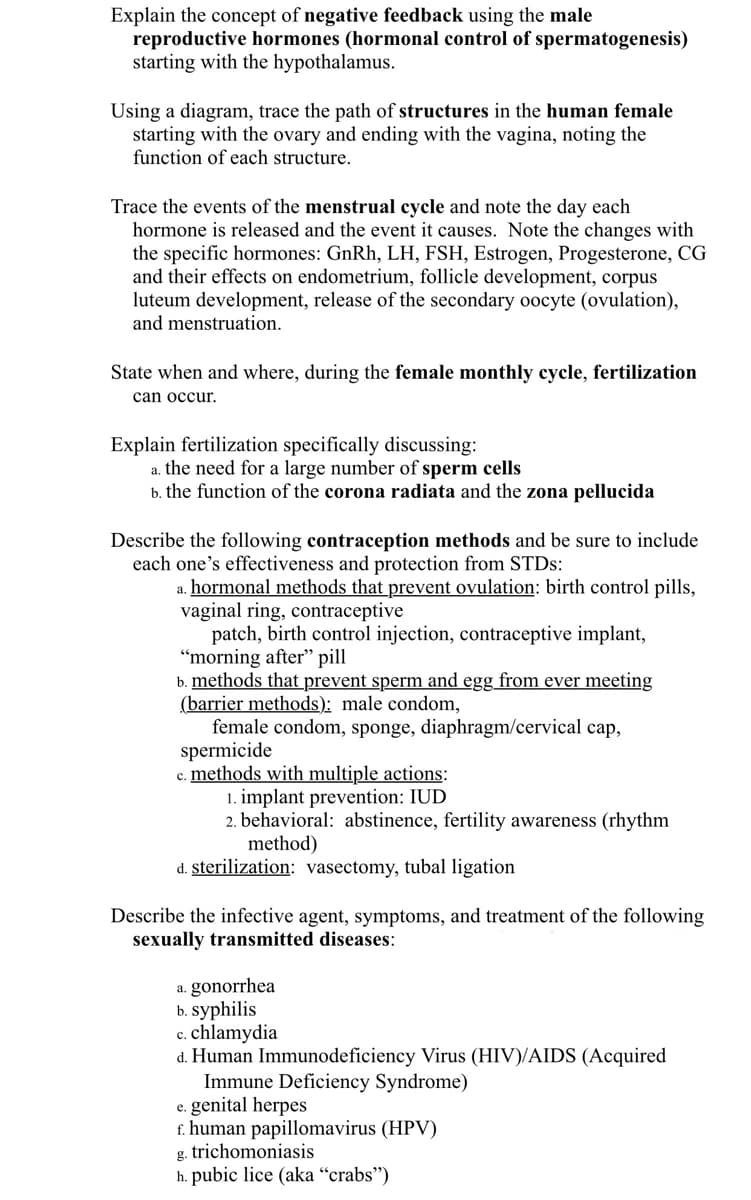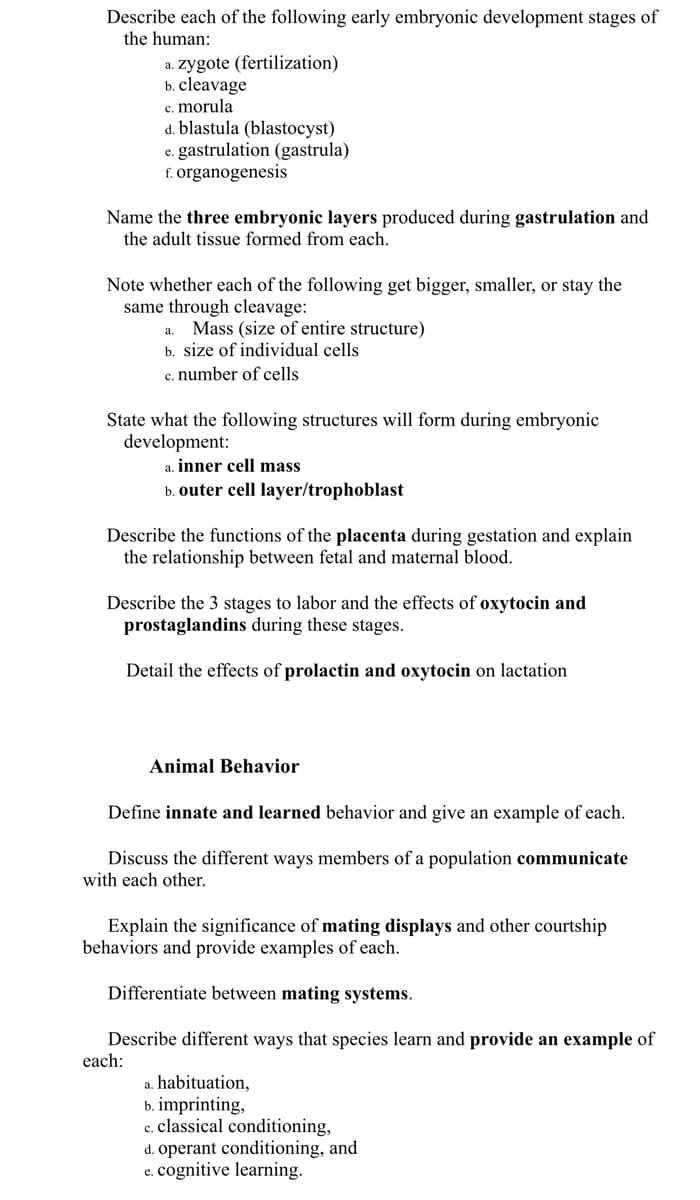Explain the concept of negative feedback using the male reproductive hormones (hormonal control of spermatogenesis) starting with the hypothalamus.
Explain the concept of negative feedback using the male reproductive hormones (hormonal control of spermatogenesis) starting with the hypothalamus.
Human Biology (MindTap Course List)
11th Edition
ISBN:9781305112100
Author:Cecie Starr, Beverly McMillan
Publisher:Cecie Starr, Beverly McMillan
Chapter17: Development And Aging
Section: Chapter Questions
Problem 2CT
Related questions
Question

Transcribed Image Text:Explain the concept of negative feedback using the male
reproductive hormones (hormonal control of spermatogenesis)
starting with the hypothalamus.
Using a diagram, trace the path of structures in the human female
starting with the ovary and ending with the vagina, noting the
function of each structure.
Trace the events of the menstrual cycle and note the day each
hormone is released and the event it causes. Note the changes with
the specific hormones: GnRh, LH, FSH, Estrogen, Progesterone, CG
and their effects on endometrium, follicle development, corpus
luteum development, release of the secondary oocyte (ovulation),
and menstruation.
State when and where, during the female monthly cycle, fertilization
can occur.
Explain fertilization specifically discussing:
a. the need for a large number of sperm cells
b. the function of the corona radiata and the zona pellucida
Describe the following contraception methods and be sure to include
each one's effectiveness and protection from STDS:
a. hormonal methods that prevent ovulation: birth control pills,
vaginal ring, contraceptive
patch, birth control injection, contraceptive implant,
“morning after" pill
b. methods that prevent sperm and egg from ever meeting
(barrier methods): male condom,
female condom, sponge, diaphragm/cervical cap,
spermicide
c. methods with multiple actions:
1. implant prevention: IUD
2. behavioral: abstinence, fertility awareness (rhythm
method)
d. sterilization: vasectomy, tubal ligation
Describe the infective agent, symptoms, and treatment of the following
sexually transmitted diseases:
a. gonorrhea
b. syphilis
c. chlamydia
d. Human Immunodeficiency Virus (HIV)/AIDS (Acquired
Immune Deficiency Syndrome)
e. genital herpes
f. human papillomavirus (HPV)
g. trichomoniasis
h. pubic lice (aka “crabs")

Transcribed Image Text:Describe each of the following early embryonic development stages of
the human:
a. zygote (fertilization)
b. cleavage
c. morula
d. blastula (blastocyst)
e. gastrulation (gastrula)
f. organogenesis
Name the three embryonic layers produced during gastrulation and
the adult tissue formed from each.
Note whether each of the following get bigger, smaller, or stay the
same through cleavage:
Mass (size of entire structure)
b. size of individual cells
c. number of cells
a.
State what the following structures will form during embryonic
development:
inner cell mass
b. outer cell layer/trophoblast
Describe the functions of the placenta during gestation and explain
the relationship between fetal and maternal blood.
Describe the 3 stages to labor and the effects of oxytocin and
prostaglandins during these stages.
Detail the effects of prolactin and oxytocin on lactation
Animal Behavior
Define innate and learned behavior and give an example of each.
Discuss the different ways members of a population communicate
with each other.
Explain the significance of mating displays and other courtship
behaviors and provide examples of each.
Differentiate between mating systems.
Describe different ways that species learn and provide an example of
each:
a. habituation,
b. imprinting,
c. classical conditioning,
d. operant conditioning, and
e. cognitive learning.
Expert Solution
This question has been solved!
Explore an expertly crafted, step-by-step solution for a thorough understanding of key concepts.
Step by step
Solved in 3 steps

Knowledge Booster
Learn more about
Need a deep-dive on the concept behind this application? Look no further. Learn more about this topic, biology and related others by exploring similar questions and additional content below.Recommended textbooks for you

Human Biology (MindTap Course List)
Biology
ISBN:
9781305112100
Author:
Cecie Starr, Beverly McMillan
Publisher:
Cengage Learning

Biology: The Unity and Diversity of Life (MindTap…
Biology
ISBN:
9781337408332
Author:
Cecie Starr, Ralph Taggart, Christine Evers, Lisa Starr
Publisher:
Cengage Learning


Human Biology (MindTap Course List)
Biology
ISBN:
9781305112100
Author:
Cecie Starr, Beverly McMillan
Publisher:
Cengage Learning

Biology: The Unity and Diversity of Life (MindTap…
Biology
ISBN:
9781337408332
Author:
Cecie Starr, Ralph Taggart, Christine Evers, Lisa Starr
Publisher:
Cengage Learning


Biology (MindTap Course List)
Biology
ISBN:
9781337392938
Author:
Eldra Solomon, Charles Martin, Diana W. Martin, Linda R. Berg
Publisher:
Cengage Learning

Anatomy & Physiology
Biology
ISBN:
9781938168130
Author:
Kelly A. Young, James A. Wise, Peter DeSaix, Dean H. Kruse, Brandon Poe, Eddie Johnson, Jody E. Johnson, Oksana Korol, J. Gordon Betts, Mark Womble
Publisher:
OpenStax College